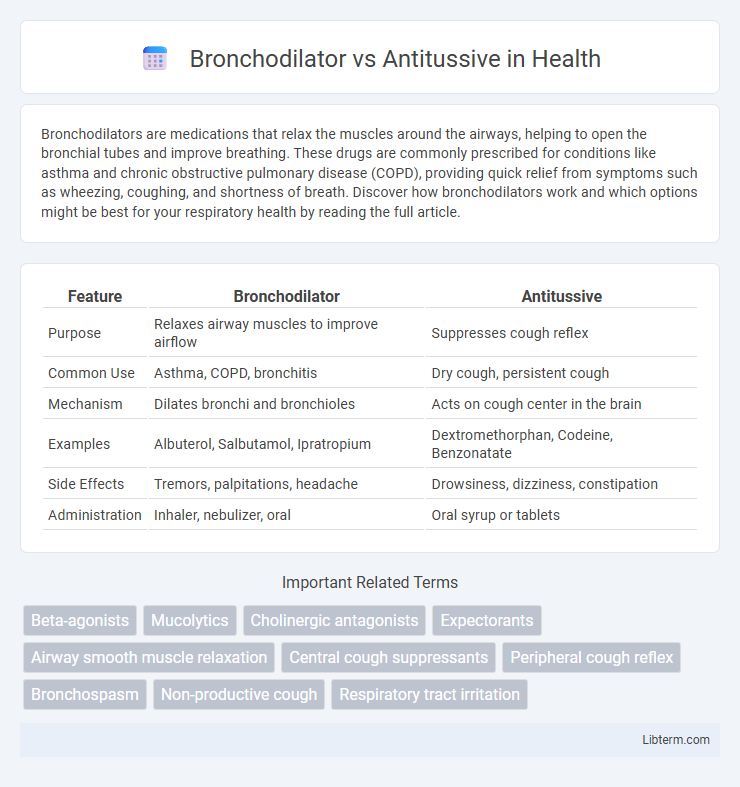Bronchodilators are medications that relax the muscles around the airways, helping to open the bronchial tubes and improve breathing. These drugs are commonly prescribed for conditions like asthma and chronic obstructive pulmonary disease (COPD), providing quick relief from symptoms such as wheezing, coughing, and shortness of breath. Discover how bronchodilators work and which options might be best for your respiratory health by reading the full article.
Table of Comparison
| Feature | Bronchodilator | Antitussive |
|---|---|---|
| Purpose | Relaxes airway muscles to improve airflow | Suppresses cough reflex |
| Common Use | Asthma, COPD, bronchitis | Dry cough, persistent cough |
| Mechanism | Dilates bronchi and bronchioles | Acts on cough center in the brain |
| Examples | Albuterol, Salbutamol, Ipratropium | Dextromethorphan, Codeine, Benzonatate |
| Side Effects | Tremors, palpitations, headache | Drowsiness, dizziness, constipation |
| Administration | Inhaler, nebulizer, oral | Oral syrup or tablets |
Introduction to Bronchodilators and Antitussives
Bronchodilators are medications that relax the muscles around the airways, improving airflow and easing breathing, commonly used in conditions like asthma and chronic obstructive pulmonary disease (COPD). Antitussives are drugs designed to suppress or reduce coughing, often employed to provide relief from persistent, non-productive coughs. Understanding the distinct roles of bronchodilators and antitussives is essential for effective respiratory disease management and symptom control.
Understanding Respiratory Medications
Bronchodilators relax the muscles around the airways, improving airflow and easing breathing in conditions such as asthma and chronic obstructive pulmonary disease (COPD). Antitussives suppress the cough reflex, providing relief from persistent or nonproductive coughs often caused by respiratory infections or irritation. Understanding the distinct mechanisms of bronchodilators and antitussives is crucial for effective treatment of respiratory symptoms and improving patient outcomes.
What Are Bronchodilators?
Bronchodilators are medications designed to relax the muscles surrounding the airways, resulting in widened bronchial passages and improved airflow to the lungs. Commonly prescribed for respiratory conditions such as asthma and chronic obstructive pulmonary disease (COPD), bronchodilators help alleviate symptoms like wheezing, shortness of breath, and coughing by opening narrowed airways. They differ from antitussives, which primarily suppress cough reflexes without directly affecting airway constriction.
What Are Antitussives?
Antitussives are medications designed to suppress or relieve coughing by acting on the cough reflex, primarily targeting the central nervous system or the respiratory tract. Common antitussive agents include dextromethorphan and codeine, which reduce the frequency and intensity of dry, non-productive coughs. Unlike bronchodilators that open airways to improve breathing in conditions like asthma or COPD, antitussives specifically aim to control cough symptoms without directly affecting airway diameter.
Mechanism of Action: Bronchodilators vs Antitussives
Bronchodilators work by relaxing the smooth muscles of the airways, leading to airway dilation and improved airflow, primarily targeting beta-2 adrenergic receptors or inhibiting muscarinic receptors to reduce bronchoconstriction. Antitussives act by suppressing the cough reflex either centrally in the brainstem, often through opioid or non-opioid receptors, or peripherally by numbing airway sensory nerves. The distinct mechanisms highlight bronchodilators' role in alleviating bronchospasm, whereas antitussives aim to inhibit the neural pathways responsible for coughing.
Common Conditions Treated
Bronchodilators primarily treat respiratory conditions such as asthma, chronic obstructive pulmonary disease (COPD), and bronchitis by relaxing airway muscles to improve airflow. Antitussives are mainly used to suppress cough symptoms caused by colds, flu, bronchitis, and other upper respiratory infections. Both medications target different aspects of respiratory health but are essential for managing symptoms associated with various pulmonary disorders.
Key Differences Between Bronchodilators and Antitussives
Bronchodilators primarily target and relax the muscles around the airways to improve airflow in respiratory conditions like asthma and chronic obstructive pulmonary disease (COPD), whereas antitussives suppress the cough reflex to reduce coughing caused by irritants or infections. Bronchodilators work by stimulating beta-2 adrenergic receptors or blocking muscarinic receptors, while antitussives act centrally on the cough center in the brain or locally on the respiratory tract. The key distinction lies in their therapeutic goals: bronchodilators enhance breathing by widening air passages, and antitussives alleviate symptoms by controlling cough frequency and severity.
Side Effects and Safety Considerations
Bronchodilators commonly cause side effects such as tremors, headache, and tachycardia, while antitussives may lead to drowsiness, dizziness, and gastrointestinal discomfort. Safety considerations for bronchodilators include monitoring cardiovascular conditions and avoiding excessive use to prevent tolerance or toxicity. Antitussives should be used cautiously in patients with respiratory depression risk or those taking central nervous system depressants to avoid enhanced sedation or respiratory compromise.
When to Use Each Medication
Bronchodilators are primarily used to relieve bronchospasm in conditions like asthma and chronic obstructive pulmonary disease (COPD), helping to open airways and improve breathing during episodes of wheezing or shortness of breath. Antitussives are indicated for suppressing dry, non-productive coughs that can disrupt sleep or cause throat irritation, but they should be avoided in productive coughs where mucus clearance is necessary. Choosing the appropriate medication depends on the underlying cause: bronchodilators target airway constriction, while antitussives manage cough reflex without addressing airway obstruction.
Final Thoughts: Choosing the Right Respiratory Treatment
Bronchodilators target airway constriction by relaxing muscles in the lungs, making them essential for treating asthma and COPD. Antitussives suppress cough reflexes to provide relief from persistent coughing, often used in conditions with non-productive coughs. Selecting the right respiratory treatment depends on symptom type, underlying condition, and medical guidance to ensure optimal airway management and patient comfort.
Bronchodilator Infographic

 libterm.com
libterm.com